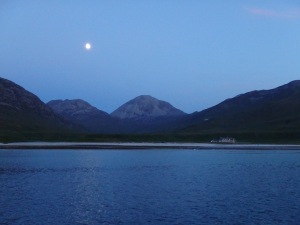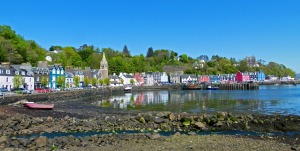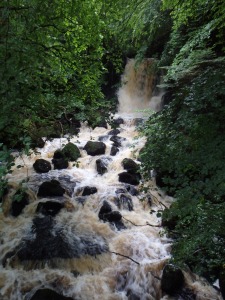Gigha is a beautiful little island lying about 25 miles NNE of the Mull of Kintyre. It covers an area of about 5 square miles and has a population of approximately 160 people. In 2002 it was placed on the market and with the assistance of various organisations was purchased by the small community. As with so many of the Hebridean Islands, there is abundant wildlife, peace and tranquillity. Its convenient location is ideal as a stopping point after the passage up the north Irish Sea and North Channel and is usually my first and last port of call in Scotland. (That’s where I am in my blog’s banner photo.)
Not far from the main village is Achamore House, the sale of which provided the bulk of the funds the islanders were required to pay back as part of a loan for the purchase of the island. Surrounding the house are Achamore Gardens, now owned and maintained by the community. We missed the peak flowering time of May/June to walk the 2 acre gardens but nevertheless it was worth a visit.
A small lake in the gardens gave a brief glimpse of a beautiful azure blue dragonfly, unfortunately too brief to photograph!
A haiku – The Dragonfly
Dragonfly, kissing water, still;
silent, gossamer wings shining.
Sun-dappled leaves sparkling bright
But here’s the lake;
In the same vicinity we came across this lovely sculpture;
Poem – The Otter
A pond, placid in summer sun
warming the earth, bringing life.
A guardian spirit standing tall.
Through unseeing eyes facing
day and night, snow, wind, rain,
scorching sun and passers-by.
Never yielding; carved in stone
in likeness of an otter.
The Paps of Jura by moonlight.
Our second stop was Loch Tarbert on the west coast of the isle of Jura, another one of my favourite places. There is spectacular scenery and wildlife; deer, wild goats, otters, seals and a wide variety of birdlife. Another attraction is its isolation, despite not being too far from civilisation it is one of the most remote anchorages in the Inner Hebrides. The loch almost bisects the island but has no roads and is several hours sail from the next nearest shelter.
One of the most outstanding features of the loch and the west coast of Jura are the raised beaches, remnants of the ice age. Well worth a look at this webpage for a brief but detailed explanation – http://www.scottishgeology.com/geo/regional-geology/grampian/west-coast-of-jura/
Example;
 © Copyright Chris Lindesay and licensed for reuse under this Creative Commons Licence
© Copyright Chris Lindesay and licensed for reuse under this Creative Commons Licence
We anchored off Glen Batrick bay where there is an isolated Victorian house, originally built as a hunting lodge and now used as a summer retreat, I believe it is owned by Lord Astor who owns the Tarbert Estate, one of three estates on the island. A more sheltered anchorage lies further up the loch, alongside the largest of the raised beaches (truly impressive), but this spot is lovely in settled weather, anchored in view of the Paps of Jura. On a previous trip I was blessed with a glorious sunset, the Paps were bathed in beautiful reds, oranges and purples, deer grazed on the beach, seals played around near the boat and I was fortunate to see a passing otter, life doesn’t get better! 🙂
Our dinghy moored alongside the jetty used by Glen Batrick house. (no road access!)
A walk ashore on a glorious summer evening ended up being an uncomfortable excursion as we became the evening meal for midges and horseflies. A day later my hand, suffering from three bites, swelled up magnificently!
It is always a joy to be in such a peaceful place; out walking, once away from Glen Batrick house, you could believe human kind doesn’t exist, such is the feeling of raw nature and solitude. In the mornings we awoke to no sound, excepting perhaps birdsong and the lapping of waves
From Jura we sailed up to the Sound of Iona and found a snug anchorage for the night at the south end of the Sound in a place called ‘Tinkers Hole’. This is a small anchorage set amongst a group of rocky islands which some have likened to a disused quarry; though it is actually quite attractive. The following morning we set sail and passed close by the island of Staffa, made famous by the extraordinary formation of basalt columns surrounding the entrance to Fingal’s cave where, on a visit in 1829, Felix Mendelssohn was inspired to write The Hebridean Overture, often known as ‘Fingal’s Cave’
After a quick sail past and photo shoot we bore off to the east towards the west coast of Mull, heading for one more of my most favoured anchorages, Carsaig Bay, tucked beneath the hills of Ulva Island which is separated from Mull by a narrow stretch of water.
Much like Jura, there is a panoramic vista of sheer beauty. 360 degrees of stunning views impossible to catch on camera without compromising the splendour, you have to be there 🙂
On another glorious sunny day we took a walk along the coast, to one side the sea, with views to the Ross of Mull, Iona, Staffa, the Treshnish Islands and Coll, to the other the towering hillside looming almost vertically up. A few glimpses were had of wild deer.
There is another side to this beautiful area. As in so many parts of Scotland it fell foul to the infamy of ‘land clearances’, an enforced simultaneous eviction of all families living in a given area such as an entire glen. Most often these evictions were sudden and brutal, whole communities were displaced from their homes at short notice, a form of ‘ethnic cleansing’. Many of the people moved on to other areas in the Highlands, Lowlands or coastal areas, many emigrated to Canada, the USA, Australia, and New Zealand.
It is sobering to think of the physical and emotional hardship placed upon the people.
A poem – The Dispossessed
Crumbling walls,
bare outlines,
mark the remains of dwellings where
people toiled,
loved and raised children.
They came with force,
‘leave!’
No choice, herded, beaten,
to submission.
The plight began, the tears, the homeless,
‘where do we go?’
‘Not our problem, we want our land.’
Land no man can own,
what right,
what man
can own mountains,
valleys or streams?
Upon what act against God
who created
for all to share,
did they deem to own?
Own what you make or earn,
you cannot own by taking
from fellow man
or God’s earth.
With few possessions, all
you could carry,
you searched new pastures,
far and wide.
Who lived, who died?
Who cared?
What became of you people,
long gone now?
Did you find fortune and joy,
or despair and poverty,
health or disease?
Was hope crushed?
I see your homes,
desolate,
abandoned.
What became of you,
poor people?
I wonder, as I pass
wild flowers
blowing in the breeze,
peace.
What became of you?
We walked more and then rested overlooking the sea, a light picnic of fruit and chocolate. Fewer insect bites than at Jura 🙂 We then made our return. Back on board we enjoyed a good curry washed down with wine in preparation for departure in the morning and said farewell to Carsaig Bay until next years voyage.
From Carsaig Bay we sailed to Tobermory on the island of Mull, a useful place to re-provision the boat after being out in the sticks for a week or so. Apart from that it is an attractive town to visit, all the seafront houses are painted in a rainbow of pastel colours. This was probably the inspiration for its use in the BBC TV childrens program Balamory, filmed largely at Tobermory and screened between 2002 and 2005.
Due to the lack of towns in the area it is a crossroads for cruising yachts, few pass by without stopping to use the small supermarket or to sample the selection of pubs and restaurants. So it is a lovely place just to sit and watch the comings and goings of many types of vessel; a seaplane was in attendance when we sailed in.
There is a pleasant walk along the tree-lined cliff edge which we set out for, only to experience the one day of heavy rainfall in our three weeks away – and without the foresight of waterproof clothing! Here also is a spectacular waterfall, the water heavily coloured by peat absorbed on its run flow down the mountains. It ends in Tobermory Bay and used to be a source of ships drinking water right up to the 1940’s when the Royal Navy had a base in Tobermory.
Two days later, a short sail down The Sound of Mull took us to Loch Aline. A secluded loch surrounded by woodland, where we relaxed on the sunny, windless afternoon and evening.
We were now at the turning point of our cruise, beginning the slow journey south, but with plenty of time on our hands to explore more places by taking relatively small hops each day, and our next stop was Puilladobhrain, (a few miles south of Oban) and translated from the Gaelic as ‘the pool of the otter’. In years gone by the small anchorage, surrounded by numerous tiny islets, was home to a community of otters but rumour has it that being such a delightful and popular anchorage in summertime they have moved on to quieter pastures!
The next day we headed to Loch Craignish for the night, anchoring off a small island, Goat Island. With little time, and thick mist, we contented ourselves with enjoying the tranquillity as the mist lent a peaceful ambiance as it hung around the hills and trees. A writers paradise!
For many years I have wanted to visit our following destination, a very small island – Eilean Mor in the McCormaig Islands. I have never been in such a tiny anchorage; apart from the anchor off the bow I had to tie a line to the shore, where mooring rings are provided to stop boats swinging around in the limited room, especially when more than one are present.
Other than two small speed boats paying a short visit when we arrived, we had the island to ourselves for the rest of the afternoon and evening. We rowed ashore and explored the reason I had been wanting to visit. The island is perhaps half a mile by a quarter but there are the remains of an old chapel (used through the years as a chapel, a house and finally an illicit distillery!), a Celtic Cross on the highest hill and a hermits retreat – a damp cave, little more than a hole, in a rock face at the south of the island. Apparently, this was for those souls for whom the lack of people and community on the island wasn’t quiet enough. It is difficult to understand how anyone could contemplate anything spiritual whilst in such extreme discomfort! Nevertheless, for us it was a beautiful place!
Just one more stop remained before our return to Gigha, the starting point for the offshore passage back to our home port on the Isle of Man, Lowlandman’s Bay on the east coast of Jura. A lovely view of the Paps of Jura which we had anchored close to nearly two weeks before on the other side of the island. Other than that, a relatively uninspiring stop, though only in comparison to the stunning places! However, we spent much time laughing at a mother and baby seal on the rocks close to shore. The mother spent the entire time sunning herself on a rock while the youngster splashed about comically, in much the same way a child would play in the bath. Occasionally the mother would turn her head towards junior as if to say ‘keep quiet!’ 🙂
 Lowlandmans Bay, playful seals.
Lowlandmans Bay, playful seals.
With no wind we motored from there to Gigha, to rest before the long haul. That, however, was broken down into smaller stages, first, Sanda Island a mile south of the Mull of Kintyre. The intention was to take a walk ashore the following morning but a heavy swell made conditions uncomfortable and we made a hasty, early departure.
 Approaching the anchorage at Sanda Island
Approaching the anchorage at Sanda Island
We then sailed across the North Channel, at the north end of the Irish Sea, bound for a small island outside Belfast Lough, Copeland island. Fifteen miles from our destination a small yacht, Lola, had become disabled, there was no wind and she had lost the use of her engine. They asked us for a tow to Bangor Marina, which I obliged; it’s an unwritten law of the sea to help others, with the philosophy ‘there but for the grace of God go I’, the sea is an unforgiving environment. I happily took the vessel in tow but was a little peeved that we wouldn’t make our destination, strong tides exist in the area and the current was due to turn against us, too soon with the tow. Fortune smiled on us; an inshore life boat RIB was out on an exercise, spotted us, and offered to take over the tow. We were free and just made our chosen anchorage as the tide turned.
 Lola under tow after RNLI vessel took over.
Lola under tow after RNLI vessel took over.
I’ve anchored at Copeland Island many times on passage and have always been the only yacht there. This time was different, it was mid summer, four other yachts were anchored and the next day it became a magnet for visitors from the mainland of Ireland; kayaks and speedboats, a passenger launch with tourists, and more small yachts and sailing dinghies, most people were heading for the lovely white sand beaches to enjoy the sun.
The penultimate leg took us down the coast of Northern Island to Strangford Lough, one of the largest sea lochs in Europe, most of which is a nature reserve and Site of Special Scientific Interest. The stay was for one night then we set sail for the Isle of Man, with a perfect, stiff sailing breeze and a steady sea, probably the best sail of the trip, a fine end to the voyage 🙂






















Pingback: The Western Isles of Scotland – ROBERT JEPSON